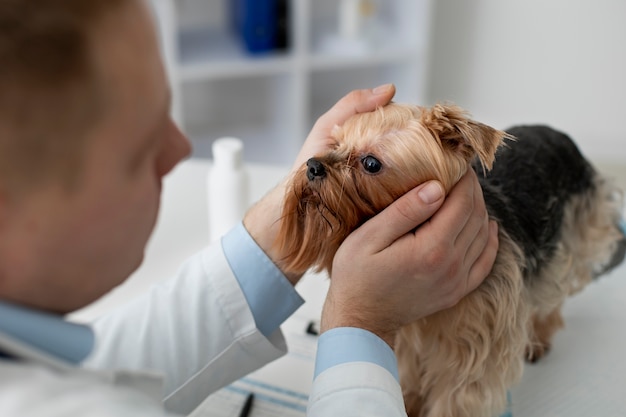When a Limp Means a Vet Visit: Limping in Pets Explained

When a Limp Means a Vet Visit: Limping in Pets Explained
If you’ve ever noticed your dog or cat suddenly favoring a leg, hesitating to jump, or moving with an awkward gait, you’re not alone. Limping in dogs and cats is a common concern for pet owners in Gilbert, IA and surrounding communities. From playful puppies to wise senior cats, any pet can experience lameness, and it’s natural to worry about what it means for your furry family member’s health. At Companion Animal Clinic, located conveniently at 143 Dunn Street, Gilbert, IA 50105, our team of veterinarians is here to help you understand when a limp signals a minor issue and when it’s time to schedule an appointment for a professional evaluation.
In this article, we’ll break down the most common causes of limping in dogs and cats, explain how to spot warning signs, and guide you through when to see a vet for limping. We’ll also share tips on home care and prevention to help keep your pet active and pain-free. Whether you’re searching for quality veterinary services near me or wondering about comprehensive pet exam options in Gilbert, IA, you’ll find practical advice and reassurance here.
Recognizing Limping in Dogs and Cats: What Pet Owners Should Watch For
Pets can’t tell us when something hurts, so identifying lameness can sometimes be tricky. Limping in dogs and cats often appears as a subtle change in the way your pet walks or moves. You may notice your dog shifting weight off one leg, or your cat hesitating to leap onto her favorite windowsill. Other signs are more obvious, such as a pronounced limp, holding up a paw, or vocalizing when moving.
Key symptoms include favoring one side, stiffness after rest, visible swelling around a joint, or licking and chewing at a paw or leg. Additionally, some pets may become withdrawn, lose interest in play, or resist being touched. In some cases, the limp comes on suddenly after a fall or rough play; in others, it may develop gradually, especially in older pets or those with underlying health conditions.
If your pet’s limp persists for more than a day, worsens over time, or is accompanied by other signs like fever or loss of appetite, it’s important to take note. These changes can signal deeper issues that require veterinary attention, especially for pet owners seeking veterinary diagnostics in Gilbert, IA.
What Causes Limping in Dogs and Cats?
There are many reasons pets may develop a limp. Understanding these can help you determine the seriousness of the issue and whether immediate care is needed.
In younger, energetic animals, sprains, strains, or minor injuries from playing or running are common causes. Puppies and kittens, with their boundless curiosity, may twist a paw or take a tumble resulting in temporary discomfort. For outdoor cats, scrapes, bites, or puncture wounds can lead to limping as well.
Older pets may experience lameness due to arthritis, degenerative joint disease, or chronic ligament problems. In larger dog breeds, conditions like hip dysplasia, cruciate ligament tears, or elbow dysplasia are relatively frequent contributors. Cats, on the other hand, can suffer from soft tissue injuries, broken claws, or even hidden fractures after a jump or fall.
Other factors include infections, abscesses, insect stings, or foreign objects like thorns lodged in a paw. Sometimes, causes are less obvious, such as nerve injuries or internal problems affecting mobility. Certain underlying illnesses, including Lyme disease or other tick-borne infections, can also result in limping and require prompt attention.
If you notice your dog or cat limping and live in Gilbert, IA, it’s helpful to remember that the local environment, such as icy sidewalks in winter or sharp objects in grassy fields, can influence the risk of injury. For comprehensive evaluation, veterinary diagnostics near me or a wellness examination may be recommended to explore underlying causes.
How Veterinarians Diagnose and Treat Limping: What to Expect at Companion Animal Clinic
Once you’ve recognized a limp, you may wonder what happens when you bring your pet in for an examination. The first step is a thorough history and physical exam by our veterinary professionals at 143 Dunn Street, Gilbert, IA 50105. We’ll ask about when you first noticed the limp, any recent injuries, and your pet’s activity level.
During the assessment, our veterinarians will gently examine your pet’s limbs, joints, and paws. We look for swelling, tenderness, or abnormal movement. If needed, advanced tools like digital radiology imaging can help identify fractures, joint problems, or foreign bodies not visible to the naked eye. In cases where soft tissue or ligament injuries are suspected, veterinary ultrasound diagnostics may provide additional insight.
Treatment options depend on the underlying cause. For mild sprains or strains, rest, anti-inflammatory medications, and supportive care are often recommended. Infections or abscesses may require antibiotics or minor surgical drainage. More serious conditions, such as ligament tears or bone fractures, might need surgical intervention; our comprehensive pet surgery services can address these cases with the expertise and care you expect from the best vet team near me.
For chronic conditions like arthritis, long-term management may involve pain relief, joint supplements, weight management, and physical therapy. Our approach is tailored to your pet’s needs, always focusing on comfort, mobility, and quality of life.
Home Care and Prevention: Helping Your Pet Heal and Stay Active
While some limping can be managed at home, knowing when to try gentle supportive care and when to seek veterinary help is crucial. If your pet’s limp is mild, not worsening, and there is no visible wound or severe pain, you can provide basic care by restricting activity, encouraging rest, and monitoring for improvement. Ensure your dog or cat has a comfortable place to rest, limit jumping or running, and avoid long walks or play sessions until the limp resolves.
Prevention is equally important. Keeping your pet at a healthy weight reduces strain on joints and ligaments. Regular exercise, suited to your pet’s age and ability, maintains muscle tone and flexibility. For cats, offering safe climbing structures indoors can help minimize risky leaps. Inspect your pet’s paws regularly for thorns, debris, or cracked nails, especially after walks or outdoor adventures in the Gilbert, IA area.
Seasonal hazards, such as icy steps in winter or hot pavement in summer, can also contribute to injuries. Being mindful of these risks helps keep your pet safe year-round. For pets with known joint issues or arthritis, our veterinary team can recommend supplements or therapies to support joint health and mobility.
When to See a Vet for Limping: Clear Guidelines for Pet Owners
It’s natural to wonder how long you should wait before making a veterinary appointment. As a general rule, any limp that lasts more than 24 hours, worsens, or is accompanied by other symptoms like swelling, bleeding, fever, or obvious pain needs prompt attention. Sudden, severe limping, inability to bear weight, or visible deformity should be considered urgent and not delayed.
Additionally, if your pet is lethargic, stops eating, or seems distressed, these are signs that the limp may be part of a more serious problem. Early intervention by a veterinarian near me can make a significant difference in both diagnosis and outcome.
At Companion Animal Clinic, we recommend scheduling a comprehensive pet exam to determine the cause of limping in dogs and cats. Our team of veterinarians in Gilbert, IA will guide you through the next steps, whether that involves further diagnostics, medical management, or surgery. Remember, timely care not only relieves your pet’s discomfort but also helps prevent complications or long-term mobility issues.
Take the Next Step: Schedule an Appointment for Limping in Dogs and Cats in Gilbert, IA
Your pet’s comfort and mobility are our top priorities. If you notice your dog or cat limping, don’t wait and wonder if it will resolve on its own. Early evaluation and treatment from a trusted vet near me can make all the difference in your pet’s recovery and long-term health.
To schedule an appointment for veterinary diagnostics in Gilbert, IA or to discuss any concerns about limping in dogs and cats, call our knowledgeable veterinary team at (515) 233-6689 or visit us at 143 Dunn Street, Gilbert, IA 50105. We are committed to providing compassionate, comprehensive care for pets in Gilbert and surrounding communities. Whether you need routine care, advanced imaging, or comprehensive pet surgery services, our veterinary professionals are here to support you and your pet every step of the way.
For more information on limping in dogs and cats, or to learn about the full range of quality veterinary services near me, reach out to Companion Animal Clinic today. Your pet’s wellbeing is worth every step.
Disclaimer: This article is for informational purposes only and does not substitute for professional veterinary advice. Always consult your veterinarian for an accurate diagnosis and tailored treatment plan for your pet.

















